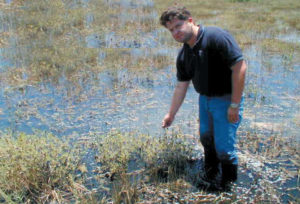Artificial wetland can effectively lower TSS, ISS

While commercial shrimp culture shows great promise for growth, the industry has been hampered with problems related to effluent and diseases. In an attempt to solve those problems, a public/private partnership was formed between Texas A&M University – Kingsville and the El Sauz Ranch. The goal of this project is to develop methods for treating waste streams and reducing viral loads in shrimp farms. This paper reports on the use of a constructed saltwater wetland system to treat effluent from a pilot facility consisting of four 2-ha ponds.
Wetland design characteristics
The constructed wetland was designed with sufficient capacity to store harvest discharge. Topsoil was removed during construction of the wetland impoundment and replaced at completion. The bottom of the wetland was not sloped. Operational depth of wetlands was 8-20 cm, with a maximum depth of 50 cm. One 20-hp pump moved 6,800 liters per minute (1,800 gpm). The design attempted to maximize sheet flow and minimize channeling.
Vegetation was selected to include plants tolerant to wide salinity ranges, emergents and submergents, frost-tolerant plants, and self-propagating plants. Candidate species included coastal cattails, rushes, black mangroves, Spartina grass, sedges, widgeon grass and chara. Operational depth of wetlands was 8-20 cm, with a maximum depth of 50 cm. One 20-hp pump moved 6,800 liters per minute (1,800 gpm).
Shrimp pond management
High Health (Litopenaeus vannamei) were stocked at 40 animals per square meter in four 2-ha ponds. Fourteen 2-hp paddlewheel aerators were used per pond. Water flowed from each culture pond through a settling basin, and then to an 8-ha constructed wetland. From the wetland, water was recirculated back into the culture ponds except at harvest time, when the facility was dewatered and the treated water was discharged off the farm. Water quality parameters were measured routinely throughout the system. Ponds were harvested after 135 to 140 days of culture.
Results
Shrimp production was satisfactory. A total of 19,000 kg of shrimp were harvested from 8 ha (2,375 kilograms per hectare). Growth rate was 1.7 grams per week. Food conversion ratio was 4:1. No disease outbreaks occurred. The wetland was effective in rapidly removing both total suspended solids (TSS) and inorganic suspended solids (ISS) from the pond effluent. After traveling through less than 2 hectares of constructed wetland, the average effluent ISS content dropped to a minimum and did not significantly improve from that point onwards.
At harvest, the ISS level in the discharge averaged approximately 25 milligrams per liter while the ISS level in the receiving stream was generally over 150 milligrams per liter. At no time was water discharged from the facility with an ISS level higher than that in the receiving stream. All water discharged from the shrimp culture facility was significantly lower in ISS and TSS than the water brought onto the facility to fill the ponds.
The dominant plant species in the constructed wetland were Widgeon grass (Ruppia maritima), Cattail (Typha latifolia), Chara (Chara spp.), Pithophora (Pithophora spp.), Southern watergrass (Hydrochloa carolinensis), Black mangrove (Avicennia germinans), Soft rush (Juncus effusus) and Fragrant waterlily (Nymphaea odorata).
Wetlands management
Recommendations Based upon experience gained in this study, we recommend that the water level in wetlands be maintained at < 5 cm of depth during establishment. Allow two years for complete establishment of vegetation. Avoid drying wetland, and avoid long-term submergence of emergent plants.
Conclusions
- An artificial wetland can effectively lower TSS and ISS in shrimp farm effluent.
- The optimum ratio of production area to treatment area is 6:1. In other words, approximately 17 percent of pond area would be needed as artificial wetlands area.
- Shallow wetland depth may facilitate plant establishment.
- Minimizing topsoil removal or replacing wetland topsoil may facilitate vegetation establishment.
- Plant succession (from terrestrial to aquatic) results in high organic load.
(Editor’s Note: This article was originally published in thwee June 2000 print edition of the Global Aquaculture Advocate.)
Now that you've finished reading the article ...
… we hope you’ll consider supporting our mission to document the evolution of the global aquaculture industry and share our vast network of contributors’ expansive knowledge every week.
By becoming a Global Seafood Alliance member, you’re ensuring that all of the pre-competitive work we do through member benefits, resources and events can continue. Individual membership costs just $50 a year. GSA individual and corporate members receive complimentary access to a series of GOAL virtual events beginning in April. Join now.
Not a GSA member? Join us.
Author
-
Ron Rosati
Professor
Patrick Respecio
Texas A&M University
Kingsville, Texas 78363 USA
Tagged With
Related Posts

Responsibility
A wider view: Consensus on seafood’s planetary and human health benefits
Several recent reports echo the message that eating sustainable seafood can help save the planet while making significant gains in public health.

Responsibility
Effluent permits commonly required by governments
A major environmental concern related to shrimp aquaculture is the potential water pollution from the release of effluent into water bodies.

Responsibility
Growth away from the coast: Examining inland shrimp farming
Inland shrimp culture has numerous advantages – improved biosecurity, lower cost of land and reduced conflicts with other users of common resources like land and water – and will continue to expand into new areas.

Responsibility
Weighing the risks of farming non-native fish species in India
Food security is a priority in India, and there is huge potential for the expanded culture of non-native fish species. While many farmers have improved their socio-economic conditions through farming non-native fish species, their spread into open water resources presents a threat to biodiversity.


